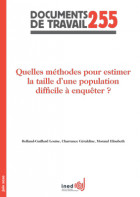
What methods can be used to estimate the size of a hard-to-survey population? [FR]
Collection : Documents de travail
n° 255, 2020, 28 pages
Choosing a survey method to estimate the size of hard-to-reach populations ere is a growing interest in surveys for marginal populations, also termed "hard-toreach" populations that is to say without sampling frame, stigmatized and rare. These surveys provide knowledge on social problems such as extreme poverty, HIV epidemic, injection drug use, to inform policy makers and service providers.
The field of hard-to-reach population is productive regarding the publications in scientific literature. Several methods have been designed to estimate the size of hard-to-reach populations, but some have applied on very restricted population, such as key populations at risk for HIV infection, and others have never been used in France. These methods require new data from surveys or administrative data.
We present these methods from a theoretical and practical perspective, their strengths and limitations, based on a literature work on these estimation methods conducted to prepare a survey on transnational assisted reproductive technologies. This presentation is meant to explain these methods and their consequences on the setting of this type of survey to the researcher, the survey staff and the statistician.
The list of methods is not exhaustive, for we focused only on the more appropriate methods to our population of interest. We identified two methods little or not mentioned in French literature: the benchmark-multiplier and the network scale-up, both promising to ensure anonymity of the respondent.

